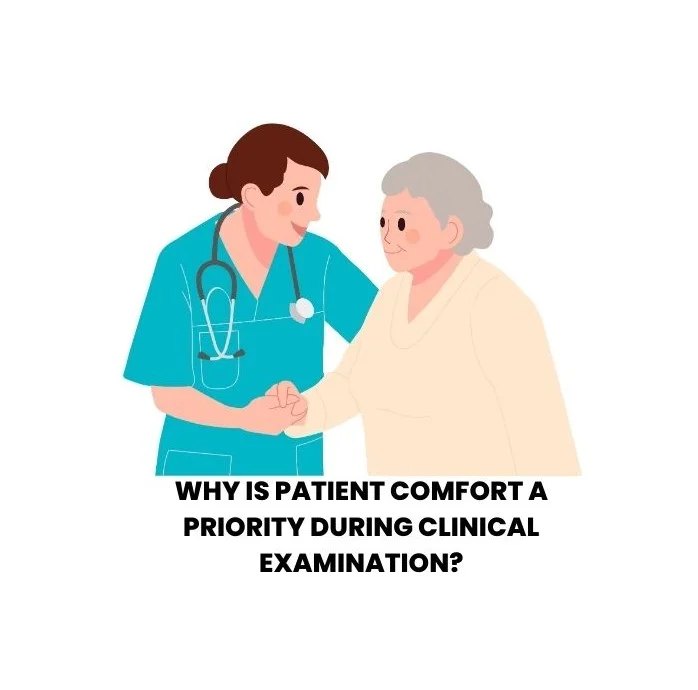Patient comfort is a paramount consideration in clinical examination, playing a pivotal role in ensuring the well-being of individuals seeking healthcare services.
This comprehensive discussion digs into the multiple reasons why patient comfort is an absolute priority during clinical examinations, supported by detailed examples illustrating its impact on the healthcare experience.

Table of Contents
ToggleBUILDING TRUST AND RAPPORT
Patient comfort is the cornerstone of establishing trust and rapport between healthcare providers and their patients.
The moment a patient steps into a healthcare facility, they are often met with anxiety, uncertainty, and vulnerability.
An environment that prioritizes their comfort helps alleviate these negative emotions, creating a conducive atmosphere for open communication and collaboration.
Example:
Imagine a patient who has been experiencing persistent chest pain.
They arrive at the hospital, understandably anxious about the potential causes of their discomfort.
If the healthcare team can create a calming and reassuring environment, the patient is more likely to share crucial details about their symptoms, medical history, and concerns.
This information is vital for an accurate diagnosis and appropriate treatment.
ENHANCING COMMUNICATION
Effective communication between patients and healthcare providers is essential for accurate diagnosis and informed decision-making.
When patients are at ease and comfortable, they are more likely to engage in meaningful conversations about their health.
Example:
A patient presenting with chronic lower back pain may be hesitant to discuss the pain’s exact location and characteristics if they feel uncomfortable or judged.
However, in a supportive and comfortable environment, they are more likely to provide a detailed description, allowing the healthcare provider to pinpoint potential causes and develop an effective treatment plan.
MINIMIZING ANXIETY AND FEAR
Clinical examinations can be intimidating for patients, particularly when they involve invasive procedures or uncomfortable positions.
Prioritizing patient comfort helps alleviate anxiety and fear, promoting a more relaxed state of mind.
Example:
Consider a patient scheduled for a colonoscopy, a procedure that can be emotionally distressing.
If the healthcare team takes steps to explain the procedure thoroughly, address the patient’s concerns, and ensure physical comfort during the process, the patient is more likely to undergo the procedure with reduced anxiety.
This not only improves the patient’s experience but also enhances the procedure’s effectiveness.
OPTIMIZING DIAGNOSTIC ACCURACY
Accurate diagnosis is the cornerstone of effective healthcare.
However, clinical signs and symptoms may be subtle and easily missed if the patient is uncomfortable or distressed during the examination.
Example:
In the case of a child with a suspected ear infection, an attentive paediatrician will prioritize the child’s comfort during the ear examination.
By creating a reassuring and comfortable environment, the child is more likely to cooperate and sit still, allowing the doctor to visualize the ear clearly and make an accurate diagnosis.
FACILITATING THOROUGH EXAMINATIONS
Thoroughness is essential in clinical examinations to ensure that no potential health issue is overlooked.
Patients who are comfortable and at ease are more likely to cooperate fully during the examination, enabling healthcare providers to perform a comprehensive assessment.
Example:
During a routine physical examination, a healthcare provider may need to palpate various areas of the patient’s abdomen to check for tenderness or abnormal masses.
If the patient is tense due to discomfort or anxiety, they may involuntarily contract their abdominal muscles, making it challenging for the provider to detect subtle abnormalities.
However, if the patient is comfortable, the examination can proceed smoothly and comprehensively.
PREVENTING DEFENSIVE POSTURING
Patients often react to discomfort or pain by adopting defensive postures, such as guarding or bracing.
These defensive responses can mask clinical signs, potentially leading to misdiagnosis or delayed treatment.
Example:
In the case of a patient with a shoulder injury, discomfort may cause them to involuntarily guard the injured shoulder by limiting movement.
If the healthcare provider does not prioritize the patient’s comfort and fails to address their pain, the examination may yield inconclusive results.
However, by ensuring the patient’s comfort and providing adequate pain relief, the provider can conduct a more accurate assessment of the shoulder’s range of motion and pinpoint the injury’s severity.
IMPROVING PATIENT COMPLIANCE AND SATISFACTION
Patient comfort directly impacts their overall satisfaction with the healthcare experience.
A comfortable and satisfied patient is more likely to adhere to treatment plans, follow up on appointments, and actively engage in their healthcare journey.
Example:
After a surgical procedure, a patient’s post-operative comfort plays a crucial role in their recovery.
If the healthcare team manages their pain effectively, addresses their concerns promptly, and provides a comfortable environment, the patient is more likely to follow prescribed medications, attend rehabilitation sessions, and experience a smoother recovery process.
UPHOLDING ETHICAL PRINCIPLES
Prioritizing patient comfort aligns with the ethical principles of beneficence and non-maleficence in healthcare.
Healthcare providers have a moral duty to promote the well-being of their patients while avoiding harm or unnecessary discomfort.
Example:
In scenarios where patients require frequent blood tests or injections, the healthcare team should strive to minimize pain and discomfort.
Using techniques like numbing creams or distraction techniques can reduce the patient’s distress, aligning with ethical principles and ensuring that the patient receives the necessary care without undue suffering.
FAQs:
Q1: What can healthcare providers do to create a comfortable environment for patients? A1: Healthcare providers can improve patient comfort by ensuring a welcoming atmosphere, effective communication, pain management, and addressing patient concerns promptly.
Q2: Are there situations where patient comfort might be challenging to prioritize? A2: While prioritizing patient comfort is crucial, some emergencies or urgent situations may require immediate medical interventions, where comfort might be secondary.
Q3: How does patient feedback contribute to enhancing comfort in healthcare facilities? A3: Patient feedback helps healthcare facilities identify areas for improvement, ensuring that patient comfort remains a top priority.
Q4: What are some common techniques for minimizing discomfort during medical procedures? A4: Techniques such as pain management, distraction methods, and explaining procedures thoroughly can help minimize discomfort during medical procedures.
Q5: How can patients communicate their comfort needs to healthcare providers effectively? A5: Patients should feel comfortable sharing their concerns and preferences with healthcare providers openly. Effective communication is key to addressing comfort needs.
CONCLUSION
Patient comfort is not merely a matter of compassion; it is a fundamental requirement for effective and ethical healthcare.
Prioritizing patient comfort during clinical examinations builds trust, enhances communication, reduces anxiety, optimizes diagnostic accuracy, facilitates thorough assessments, prevents defensive posturing, improves patient compliance, and upholds ethical standards.
Ultimately, a comfortable patient is more likely to have a positive healthcare experience, leading to better outcomes and a stronger doctor-patient relationship.













Leave a Reply